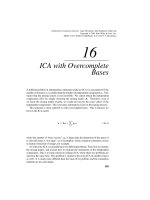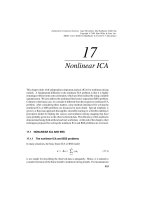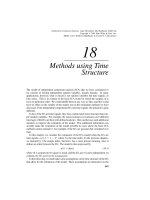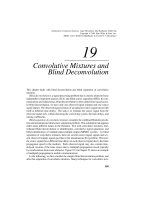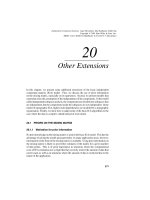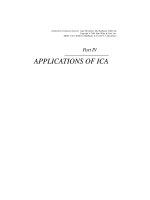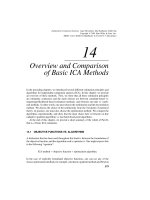Tài liệu Independent Component Analysis - Chapter 22: Brain Imaging Applications docx
Bạn đang xem bản rút gọn của tài liệu. Xem và tải ngay bản đầy đủ của tài liệu tại đây (1.34 MB, 10 trang )
22
Brain Imaging Applications
With the advent of new anatomical and functional brain imaging methods, it is now
possible to collect vast amounts of data from the living human brain. It has thus
become very important to extract the essential features from the data to allow an
easier representation or interpretation of their properties. This is a very promising
area of application for independent component analysis (ICA). Not only is this an
area of rapid g rowth and great importance; some kinds of brain imaging data also
seem to be quite well described by the ICA model. This is especially the case
with electroencephalograms (EEG) and magnetoencephalograms (MEG), which are
recordings of electric and magnetic fields of signals emerging from neural currents
within the brain. In this chapter, we review some of these brain imaging applications,
concentrating on EEG and MEG.
22.1 ELECTRO- AND MAGNETOENCEPHALOGRAPHY
22.1.1 Classes of brain imaging techniques
Several anatomical and functional imaging methods have been developed to study the
living human brain noninvasively, that is, without any surgical procedures. One class
of methods gives anatomical (structural) images of the brain with a high spatial res-
olution, and include computerized X-ray tomography (CT) and magnetic resonance
imaging (MRI). Another class of methods gives functional information on which
parts of the brain are activated at a given time. Such brain imaging methods can help
in answering the question: What parts of the brain are needed for a given task?
407
Independent Component Analysis. Aapo Hyv
¨
arinen, Juha Karhunen, Erkki Oja
Copyright
2001 John Wiley & Sons, Inc.
ISBNs: 0-471-40540-X (Hardback); 0-471-22131-7 (Electronic)
408
BRAIN IMAGING APPLICATIONS
Well-known functional brain mapping methods include positron emission tomog-
raphy (PET) and functional MRI (fMRI), which are based on probing the changes
in metabolic activity. The time resolution of PET and fMRI is limited, due to the
slowness of the metabolic response in the brain, which is in the range of a few
seconds.
Here we concentrate on another type of functional brain imaging methods that are
characterized by a high time resolution. This is possible by measuring the electrical
activity within the brain. Electrical activity is the fundamental means by which
information is transmitted and processed in the nervous system. These methods are
the only noninvasive ones that provide direct information about the neural dynamics
on a millisecond scale. As a trade-off, the spatial resolution is worse than in fMRI,
being about 5 mm, under favorable conditions. The basic methods in this class
are electroencephalography(EEG) and magnetoencephalography (MEG) [317, 165],
which we describe next. Our exposition is based on the one in [447]; see also [162].
22.1.2 Measuring electric activity in the brain
Neurons and potentials
The human brain consists of approximately to
neurons [230]. These cells are the basic information-processing units. Signals
between neurons are transmitted by means of action potentials, which are very short
bursts of electrical activity. The action potential is transformed in the receiving
neuron to what is called a postsynaptic potential that is longer in duration, though
also weaker. Single action potentials and postsynaptic potentials are very weak and
cannot be detected as such by present noninvasive measurement devices.
Fortunately, however, neurons that have relatively strong postsynaptic potentials
at any given time tend to be clustered in the brain. Thus, the total electric current
produced in such a cluster may be large enough to be detected. This can be done by
measuring the potential distribution on the scalp by placing electrodes on it, which
is the method used in EEG. A more sophisticated method is to measure the magnetic
fields associated with the current, as is done in MEG.
EEG and MEG
The total electric current in an activated region is often modeled
as a dipole. It can be assumed that in many situations, the electric activity of the brain
at any given point of time can be modeled by only a very small number of dipoles.
These dipoles produce an electric potential as well as a magnetic field distribution
that can be measured outside the head. The magnetic field is more local, as it does
not suffer from the smearing caused by the different electric conductivities of the
several layers between the brain and the measuring devices seen in EEG. This is one
of the main advantages of MEG, as it leads to a much higher spatial resolution.
EEG is used extensively for monitoring the electrical activity within the human
brain, both for research and clinical purposes. It is in fact one of the most widespread
brain mapping techniques to date. EEG is used both for the measurement of sponta-
neous activity and for the study of evoked potentials. Evoked potentials are activity
triggered by a particular stimulus that may be, for example, auditory or somatosen-
sory. Typical clinical EEG systems use around 20 electrodes, evenly distributed
ELECTRO- AND MAGNETOENCEPHALOGRAPHY
409
over the head. State-of-the-art EEGs may consist of a couple hundred sensors. The
signal-to noise ratio is typically quite low: the background potential distribution is
of the order of 100 microvolts, whereas the evoked potentials may be two orders of
magnitude weaker.
MEG measurements give basically very similar information to EEG, bu t with a
higher spatial resolution. MEG is mainly used for basic cognitive brain research.
To measure the weak magnetic fields of the brain, superconducting quantum inter-
ference devices (SQUIDs) are needed. The measurements are carried out inside a
magnetically shielded room. The superconducting characteristics of the device are
guaranteed through its immersion in liquid helium, at a temperature of .
The experiments is this chapter were conducted using a Neuromag-122 device,
manufactured by Neuromag Ltd., and located at the Low Temperature Laboratory of
the Helsinki University of Technology. The whole-scalp sensor array in this device
is composed of 122 sensors (planar gradiometers), organized in pairs at 61 locations
around the head, measuring simultaneously the tangential derivatives of the magnetic
field component normal to the helmet-shaped bottom of the dewar. The sensors are
mainly sensitive to currents that are directly below them, and tangential to the scalp.
22.1.3 Validity of the basic ICA model
The application of ICA to the study of EEG and MEG signals assumes that several
conditions are verified, at least approximately: the existence of statistically inde-
pendent source signals, their instantaneous linear mixing at the sensors, and the
stationarity of the mixing and the independent components (ICs).
The independence criterion considers solely the statistical relations between the
amplitude distributions of the signals involved, and not the morphology or physiology
of neural structures. Thus, its validity depends on the experimental situation, and
cannot be considered in general.
Because most of the energy in EEG and MEG signals lies below 1 kHz, the so-
called quasistatic approximation of Maxwell equations holds, and each time instance
can be considered separately [162]. Therefore, the propagation of the signals is
immediate, there is no need for introducing any time-delays, and the instantaneous
mixing is valid.
The nonstationarity of EEG and MEG signals is well documented [51]. When
considering the underlying source signals as stochastic processes, the requirement
of stationarity is in theory necessary to guarantee the existence of a representative
distribution of the ICs. Yet, in the implementation of batch ICA algorithms, the data
are considered as random variables, and their distributions are estimated from the
whole data set. Thus, the nonstationarity of the signals is not really a violation of the
assumptions of the model. On the other hand, the stationarity of the mixing matrix A
is crucial. Fortunately, this assumption agrees with widely accepted neuronal source
models [394, 309].
410
BRAIN IMAGING APPLICATIONS
22.2 ARTIFACT IDENTIFICATION FROM EEG AND MEG
As a first application of ICA on EEG and MEG signals, we consider separation of
artifacts. Artifacts mean signals not generated by brain activity, but by some external
disturbances, such as muscle activity. A typical example is ocular artifacts, generated
by eye muscle activity.
A review on artifact identification and removal, with special emphasis on the ocular
ones, can be found in [56, 445]. The simplest, and most widely used method consists
of discarding the portions of the recordings containing attributes (e.g., amplitude
peak, frequency contents, variance and slope) that are typical of artifacts and exceed
a determined threshold. This may lead to significant loss of data, and to complete
inability of studying interesting brain activity occuring near or during strong eye
activity, such as in visual tracking experiments.
Other methods include the subtraction of a regression portion of one or more
additional inputs (e.g., from electrooculograms, electrocardiograms, or electromyo-
grams) from the measured signals. This technique is more likely to be used in EEG
recordings, but may, in some situations, be applied to MEG. It should be noted that
this technique may lead to the insertion of undesirable n ew artifacts into the brain
recordings [221]. Further methods include the signal-space projection [190], and
subtracting the contributions of modeled dipoles accounting for the artifact [45]. In
both of these latter methods we need either a good model of the artifactual source
or a considerable amount of data where the amplitude of the artifact is much higher
than that of the EEG or MEG.
ICA gives a method for artifact removal where we do not need an accurate model
of the process that generated the artifacts; this is the blind aspect of the method.
Neither do we need specified observation intervals that contain mainly the artifact,
nor additional inputs; this is the unsupervised aspect of the method. Thus ICA
gives a promising method for artifact identification and removal. It was shown in
[445, 446] and [225] that artifacts can indeed be estimated by ICA alone. It turns out
that the artifacts are quite independent from the rest of the signal, and thus even this
requirement of the model is reasonably well fulfilled.
In the experiments on MEG artifact removal [446], the MEG signals were recorded
in a magnetically shielded room with the 122-channel whole-scalp magnetometer
described above. The test person was asked to blink and make horizontal saccades,
in order to produce typical ocular (eye) artifacts. Moreover, to produce myographic
(muscle) artifacts, the subject was asked to bite his teeth for as long as 20 seconds.
Yet another artifact was created by placing a digital watch one meter away from
the helmet into the shielded room. Figure 22.1 presents a subset of 12 artifact-
contaminated MEG signals, from a total of 122 used in the experiment. Several
artifact structures are evident from this figure, such as eye and muscle activity.
The results of artifact extraction using ICA are shown in Fig. 22.2. Components
IC1 and IC2 are clearly the activations of two different muscle sets, whereas IC3
and IC5 are, respectively, horizontal eye movements and blinks. Furthermore, other
disturbances with weaker signal-to-noise ratio, such as the heart beat and a digital
watch, are extracted as well (IC4 and IC8, respectively). IC9 is probably a faulty
ANALYSIS OF EVOKED MAGNETIC FIELDS
411
1
1
2
2
3
3
4
4
5
5
6
6
MEG
saccades blinking biting
Fig. 22.1
A subset of 12 spontaneous MEG signals from the frontal, temporal and occipital
areas. The data contains several types of artifacts, including ocular and muscle activity, the
cardiac cycle, and environmental magnetic disturbances. (Adapted from [446].)
sensor. ICs 6 and 7 may be breathing artifacts, or alternatively artificial bumps
caused by overlearning (Section 13.2.2). For each component the left, back and right
views o f the field patterns are shown. These field patterns can be computed from the
columns of the mixing matrix.
22.3 ANALYSIS OF EVOKED MAGNETIC FIELDS
Evoked magnetic fields, i.e., the magnetic fields triggered by an external stimulus, are
one of the fundamental research methods in cognitive brain research. State-of-the-art
approaches for processing magnetic evoked fields are often based on a careful expert
scrutiny of the complete data, which can be either in raw format or averaged over
several responses to repeating stimuli. At each time instance, one or several neural
sources are modeled, often as dipoles, so as to p roduce as good a fit to the data as
possible [238]. The choice of the time instances where this fitting should be made,
as well as the type of source models employed, are therefore crucial. Using ICA, we
can again obtain a blind decomposition without imposing any a priori structure on
the measurements.
The application of ICA in event related studies was first introduced in the blind
separation of auditory evoked potentials in [288]. This method has been further
developed using magnetic auditory and somatosensory evoked fields in [449, 448].
Interestingly, the most significant independent components that were found in these
studies seem to be of dipolar nature. Using a dipole model to calculate the source
412
BRAIN IMAGING APPLICATIONS
IC1
IC2
IC3
IC4
IC5
IC6
IC7
IC8
IC9
10 s
Fig. 22.2
Artifacts found from MEG data, using the FastICA algorithm. Three vie ws of the
field patterns generated by each independent component are plotted on top of the respective
signal. Full lines correspond to magnetic flu x exiting the head, whereas the dashed lines
correspond to the flux inwards. Zoomed portions of some of the signals a re shown as well.
(Reprinted from [446], reprint permission and cop yright by the MIT Press.)
ICA APPLIED ON OTHER MEASUREMENT TECHNIQUES
413
locations, we have found them to fall on very plausible brain areas. Thus, ICA
validates the conventional dipole modeling assumption in these studies. Future
studies, though, will probably find cases where the dipole model is too restrictive.
In [448], ICA was shown to be able to differentiate between somatosensory and
auditory brain responses in the case of vibrotactile stimulation, which, in addition to
tactile stimulation, also produced a concomitant sound. Principal component analysis
(PCA) has often been used to decompose signals of this kind, but as we have seen
in Chapter 7, it cannot really separate independent signals. In fact, computing the
principal components of these signals, we see that most of the principal components
still represent combined somatosensory and auditory responses [448]. In contrast,
computing the ICs, the locations of the equivalent current sources fall on the expected
brain regions for the particular stimulus, showing separation by modality.
Another study was conducted in [449], using only averaged auditory evoked fields.
The stimuli consisted of 200 tone bursts that were presented to the subject’s right
ear, using 1 s interstimulus intervals. These bursts had a duration of 100 ms, and
a frequency of 1 kHz. Figure 22.3 shows the 122 averages of the auditory evoked
responses over the head. The insert, on the left, shows a sample enlargement of such
averages, for an easier comparison with the results depicted in the next figures.
Again, we see from Figs 22.4 a and 22.4 b that PCA is unable to resolve the
complex brain response, whereas the ICA technique produces cleaner and sparser
response components. For each component presented in Fig. 22.4 a and Fig. 22.4 b,
left, top and, right side views of the corresponding field pattern are shown. Note that
the first principal component exhibits clear dipole-like pattern both over the left and
the right hemispheres, corroborating the idea of an unsuccessful segmentation of the
evoked response. Subsequent principal components, however, tend to have less and
less structured patterns.
From the field patterns associated with the independent components we see that
the evoked responses of the left hemisphere are isolated in IC1 and IC4. IC2 has
stronger presence over the right hemisphere, and IC3 fails to show any clear field
pattern structure. Furthermore, we can see that IC1 and IC2 correspond to responses
typically labeled as N1m, with the characteristic latency of around 100 ms after
the onset of the stimulation. The shorter latency of IC1, mainly reflecting activity
contralateral to the stimulated ear, agrees with the known information available for
such studies.
22.4 ICA APPLIED ON OTHER MEASUREMENT TECHNIQUES
In addition to the EEG/MEG results reported here, ICA has been applied to other
brain imaging and biomedical signals as well:
Functional magnetic resonance images (fMRI). One can use ICA in two dif-
ferent ways, separating either independent spatial activity patterns [297], or
independent temporal activation p atterns [50]. A comparison o f the two modes
414
BRAIN IMAGING APPLICATIONS
Left side Right side
MEG25
MEG83
MEG sample
MEG60
(MEG-L)
MEG10
(MEG-R)
1 0 1 2 3 4 5
-
Fig. 22.3
Averaged auditory evoked responses to 200 tones, using MEG. Channels MEG10
and MEG60 are used in Fig. 22.4 as representatives of one left-hemisphere and one right-
hemisphere M EG signal. Each tick in the MEG sample corresponds to 100 ms, going from
100 ms before stimulation onset to 500 ms after. (Adapted from [449].)
can be found in [367]. A combination of the two modes can be achieved by
spatiotemporal ICA, see Section 20.1.4.
Optical imaging means directly “photographing” the surface of the brain after
making a hole in the skull. Application of ICA can be found in [374, 396]. As
in the case of fMRI signals, this is a case of separating image mixtures as in the
example in Fig. 12.4. Some theory for this particular case is further developed
in [164, 301]; also the innovations processes may be useful (see Section 13.1.3
and [194]).
Outside the area of brain imaging, let us mention applications to the removal of
artifacts from cardiographic (heart) signals [31, 459] and magnetoneurographic
signals [482]. The idea is very similar to the one used in MEG artifact removal.
Further related work is in [32, 460]. Another n euroscientific application is in
intracellular calcium spike analysis [375].
22.5 CONCLUDING REMARKS
In this chapter we have shown examples of ICA in the analysis of brain signals.
First, ICA was shown to be suitable for extracting different types of artifacts from
EEG and MEG data, even in situations where these disturbances are smaller than the
background brain activity.
CONCLUDING REMARKS
415
1
0 1 2 3 4 5
1 0 1 2 3 4 5
-
PC1
PC2
PC3
PC4
PC5
IC1
IC2
IC3
IC4
-
a)
b)
Fig. 22.4
Principal (a) and independent (b) components found from the auditory evoked field
study. For each component, both the activation signal and t hree views of the corresponding
field pattern are p lotted. (Adapted from [449].)
416
BRAIN IMAGING APPLICATIONS
Second, ICA can be used to decompose evoked fields or potentials. For example,
ICA was able to differentiate between somatosensory and auditory brain r esponses in
the case of vibrotactile stimulation. Also, it was able to discriminate between the ipsi-
and contralateral principal responses in the case of auditory evoked potentials. In
addition, the independent components, found with no other modeling assumption than
their statistical independence, exhibit field patterns that agree with the conventional
current dipole models. The equivalent current dipole sources corresponding to the
independent components fell on the brain regions expected to be activated by the
particular stimulus.
Applications of ICA have been proposed for analysis of other kinds of biomedical
data as well, including fMRI, optical imaging, and ECG.

